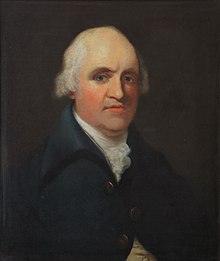James Pettit Andrews
James Pettit Andrews | |
|---|---|
 James Pettit Andrews, portrait from the 1790s by Samuel Drummond | |
| Born | 1737 |
| Died | 6 August 1797 |
| Known for | historian, antiquary |
| Notable work | History of Great Britain connected with the Chronology of Europe from Caesar's Invasion to Accession of Edward VI |
James Pettit Andrews (1737[1]– 6 August 1797) was an English historian and antiquary.
Life
He was the younger son of Joseph Andrews of Shaw House, near Newbury in Berkshire, and his second wife Elizabeth Pettit; Sir Joseph Andrews, 1st Baronet (1727–1800) was his elder brother.[2] He was educated privately, and having taken to the law was one of the magistrates at the police court in Queen Square, Westminster, from 1792 to his death.[3]
Andrews built himself the Strawberry Hill Gothic mansion of Donnington Grove, near the family home, in 1763, designed by John Chute. He sold the house in 1783.[2] He was a regular participant in the work of the Committee for the Relief of the Black Poor in the 1780s.[4]
Andrews died at Brompton and was buried in Hampstead Church.[5]
Works
His major work was a History of Great Britain connected with the Chronology of Europe from Caesar's Invasion to Accession of Edward VI, in 2 volumes (London, 1794–1795). A portion of the history of England is given on one page, facing a general sketch of the contemporany history of Europe on the opposite page. He also wrote a History of Great Britain from Death of Henry VIII to Accession of James VI of Scotland – a continuation of Robert Henry's History of Great Britain, which left off at the death of Henry VIII – published in 1796 and again in 1806.[1]
Andrews translated a German tragedy of Christoph Unzer with Henry James Pye. It was published in 1798 as The Inquisitor.[2][6] Others works include The Savages of Europe (London, 1764), a satire on the English which he translated from the French of Robert-Martin Lesuire (1737–1815) and Louvel; and Anecdotes Ancient and Modern (London, 1789), a collection of gossip.[1]
Family
Andrews married Anne, daughter of Thomas Penrose, rector of Newbury, and sister of Thomas Penrose the poet. He edited an edition (1781) of his brother-in-law's works.[2]
References
- ^ a b c Stephen, Leslie, ed. (1885). . Dictionary of National Biography. Vol. 1. London: Smith, Elder & Co.
- ^ a b c d Marchand, J. A. "Andrews, James Pettit". Oxford Dictionary of National Biography (online ed.). Oxford University Press. doi:10.1093/ref:odnb/525. (Subscription or UK public library membership required.)
- ^ Chisholm 1911.
- ^ Stephen J. Braidwood (1 January 1994). Black Poor and White Philanthropists: London's Blacks and the Foundation of the Sierra Leone Settlement, 1786-1791. Liverpool University Press. p. 65. ISBN 978-0-85323-377-0. Retrieved 31 August 2013.
- ^ Daniel Lysons (1811). The Environs of London: Kent, Essex, and Herts. Printed for T. Cadell and W. Davies. pp. 360–. Retrieved 31 August 2013.
- ^ George Watson; Ian Roy Willison (1971). The New Cambridge Bibliography of English Literature: 1660-1800 / edited by George Watson. Cambridge University Press. p. 1968. ISBN 978-0-521-07934-1. Retrieved 31 August 2013.
- Attribution
- This article incorporates text from a publication now in the public domain: Chisholm, Hugh, ed. (1911). "Andrews, James Pettit". Encyclopædia Britannica. Vol. 1 (11th ed.). Cambridge University Press.
